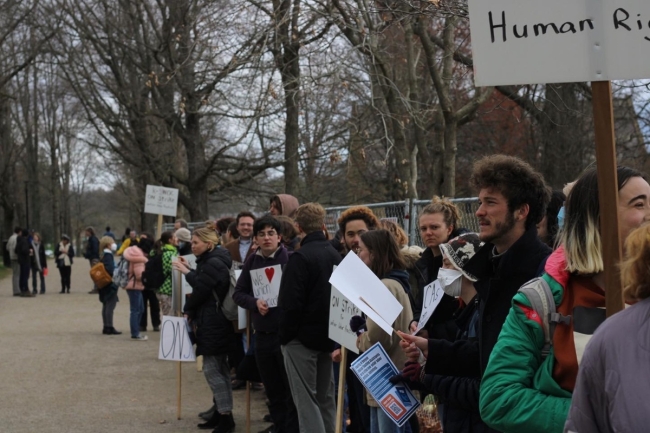You have /5 articles left.
Sign up for a free account or log in.

Student workers from Kenyon College are striking against what they say are unfair labor practices.
Courtesy of Sally Smith
Nick Becker joined the student workers’ strike at Kenyon College not only to support his classmates but also to register his own discontent with the administration.
Becker, a senior, is a “helpliner,” someone who helps solve technical issues as part of Kenyon’s library and information services. He and the 14 other helpliners on campus are striking in solidarity with the community advisers—Kenyon’s term for residential advisers—who went on strike April 11 to protest what they claim are unfair labor practices.
“I would say a large reason helpliners are unanimously on strike—which is not the case for every single workplace—is because we’ve really seen the college’s lack of willingness to engage with us as a union, and that has produced a lot of disrespect about student work in general,” he said.
The strike that started with Kenyon’s community advisers has expanded to include student workers not just from library and information services but also from the campus bookstore, the career development office, the writing center, Kenyon’s farm and the language apprenticeship program. The strikers’ main goal is to get the college to recognize the Kenyon Student Worker Organizing Committee (K-SWOC/UE) as a union.
All told, 135 members of K-SWOC/UE, which represents approximately 60 percent of Kenyon’s student workers, are on strike—including 18 of 34 community advisers. So far, 300 student workers have signed union cards, meaning they’re members of the union even though Kenyon hasn’t recognized it, according to K-SWOC/UE spokesperson Sally Smith, a junior at the college.
“Student workers are striking over unfair labor practices committed against the community advisers,” said Smith. “There’s always a variety of reasons why individual workers have gotten to a point where they’re willing to take action. In any circumstance, I think that there’s been a culture of disrespect.”
Becker expressed resentment about the way the administration has responded to K-SWOC/UE’s efforts to unionize.
“Through Kenyon’s legal arguments, they’ve said that student workers are inessential—that it’s really just like a hobby for students to take on,” Becker said. “I think helpliners really took offense to that—it’s really just like a slap in the face in terms of completely misrepresenting the work we do, and the essentiality that we are for professors, staff and students.”
Kenyon has said it will not voluntarily recognize an undergraduate union. Kenyon president Sean Decatur issued a statement in 2020 explaining the college’s stance against unions.
“Our position has not changed,” Kenyon College spokesperson Janet Marsden wrote in an email about the ongoing student strike. “Our decision was a principled one, rooted in our belief that the fundamental relationship we have with students is educational, and that campus work exists to further that education and make it financially accessible to students across incomes.”
At the same time, Marsden acknowledged that students are entitled to express their discontent by striking.
“At Kenyon, we respect the rights of students and all members of the community to peacefully protest and express their views on any topic,” she wrote. “During both the one-day strike in March [by student workers at Kenyon Farm] and the strike underway now, our goal has been to ensure that all students, including striking students, continue to receive an excellent education and enjoy the many resources Kenyon provides, without retaliation or discrimination.”
She noted that 80 percent of the college’s student workers—including those who are not members of K-SWOC/UE—have chosen not to participate in the current strike.
Marsden wrote that the college has managed to continue services jeopardized by the missing workers by relying on the college’s professional staff. Among other things, staff have filled in for the striking students by accompanying residence advisers on rounds, designing special study sessions and managing requests for technical assistance, for which she said the college is thankful.
Background of the Strike
The latest labor unrest at Kenyon started in March, when student workers at the Kenyon Farm held a one-day strike after the college announced it was canceling the farm’s residential program, which allowed between four and six students to live in a farmhouse and perform agricultural work near campus.
Then, last month, community advisers went on strike to protest the college’s announcement that it would change compensation for the position from a wage system to a stipend of $10,000 a year beginning in the 2022–23 academic year. Student workers argued the move would declassify them from their status as statutory employees under the National Labor Relations Act and the Fair Labor Standards Act, making them ineligible for minimum wage and overtime regulations and unable to unionize. Community adviser Ilan Magnani said the change upset many community advisers, who often work overtime beyond their mandated 18 hours each week.
“The fact that this happened in the midst of our organizing for a union, and the fact that CAs are the workplace with the highest number of hours per week, we understood this change to a stipend model as an attack on our ability to identify ourselves as workers and to organize alongside student workers in various workplaces on campus,” said Magnani.
Kenyon administrators said they changed the payment model to a stipend because they believe it “better reflects the leadership opportunity that the CA role represents,” according to a spokesperson. “The relationship CAs have with the College does not change, just the method of payment.”
Most of the striking student workers hold positions that end around the same time as the academic year, May 13, Smith said. She expects the strike to end then and doubts it will resume next fall.
However, the National Labor Relations Board scheduled a status conference May 9 to discuss the specifics of a union election between K-SWOC/UE and Kenyon College, which will determine who’s included in the bargaining unit.
When asked if Kenyon plans to hold any kind of discussion with K-SWOC/UE over their demands, Marsden said the college is always open to listening to student concerns. In fact, the administration has had many conversations with members of K-SWOC/UE over the past year and a half—including after K-SWOC/UE filed a petition with the National Labor Relations Board for a union election last October. However, because Kenyon will not recognize K-SWOC/UE, the college will not negotiate with the organizing committee or others, Marsden said.
To make up for the lost funds of student workers, K-SWOC/UE has raised more than $17,000 to distribute to those on strike.
Smith, Becker and Magnani all said they’d rather be working, but they feel they have no choice but to strike because of Kenyon’s intractable position.
“Nobody wants to be on strike,” Smith said. “I don’t want to be on strike right now. I like my job. I’ve been working on a project that I want to go back to, and I think that’s true for a lot of co-workers. The lack of willingness of the administration to work with student workers is really frustrating for a lot of people, myself included.”
Student Unions Are a Growing Trend
Kenyon College isn’t the only institution with a student worker union. Others include Grinnell College, Dartmouth College and Wesleyan University, where students have all successfully voted to unionize under the National Labor Relations Board.
This is part of a growing trend, said Tarini Hardikar, a chemistry graduate student at the University of California, Berkeley, and a member of the Student Researchers United bargaining team, a subsidiary of the United Auto Workers.
“Issues like low pay, housing insecurity and harassment and discrimination are rampant in academic workplaces,” Hardikar said. “Unions give workers the tools to create change on those issues. Through our unions, academic workers can democratically decide what changes to demand and then demonstrate our collective power to win the improvements we need at the negotiating table.”
Currently, UAW 2865 represents over 19,000 academic student employees across the University of California system, including teaching assistants, graduate student instructors, tutors and more. Additionally, UAW represents more than 100,000 workers at academic institutions across the U.S., Hardikar said.
Having a student workers’ union puts institutions in a better position to do quality research and give students the education they deserve, Hardikar said.
“At our last union rally, there was a sign that said, ‘We want to be researching, not house searching!’ and that’s exactly the point—we can’t do our jobs well when we are struggling to make enough money to find an affordable place to live,” Hardikar said. “Unions improve universities by making academic careers sustainable and accessible to people from diverse backgrounds and making the workplace more democratic.”









